- Submissions

Full Text
Examines in Marine Biology & Oceanography
The Impact of Underwater Sound on Aquatic Animals – And Especially Fishes
Anthony Donald Hawkins*
United Kingdom
*Corresponding author: Anthony Donald Hawkins, Kincraig, Blairs, Aberdeen, Scotland, United Kingdom
Submission: May 30, 2022;Published: June 02, 2022

ISSN 2578-031X Volume4 Issue5
Abstract
Underwater sounds from human sources can have detrimental effects upon aquatic animals, including fishes, and currently such sounds are very common. It is important to examine such anthropogenic sounds and their effects upon aquatic animals, so that it is possible to introduce protective regulations. Fishes and other aquatic animals can detect underwater sounds and use them to obtain key information about the environment around them. Sounds travel rapidly over great distances in water and can provide detailed information on the presence of prey, predators, and related fishes, while the overall acoustic scene provides the fishes with key information about their environment.
Although some of the background noise is generated by natural sources, including the precipitation of rain and snow, and wind and waves, many underwater sounds now come from anthropogenic sources. Some of these human-made sounds can kill or injure fishes and other aquatic animals, also impairing their hearing, and altering their behavior. There is a need for more work on the impact of human- made underwater noise upon the fitness of aquatic animals. This paper considers the gaps in information that must be resolved. The effects that need to be considered include death and injuries, physiological effects, and changes in behavior.
Introduction
There are current problems for all aquatic animals, including fishes. Many of them are now in a very poor state. Current concerns about these problems tend to focus on the effects of Climate Change; Chemical Pollution; Fishing; and other Human Activities. It is mainly animals that live within the water that are adversely influenced by sounds. Climate change, fishing and pollution activities by humans that have reduced aquatic animals have also affected offshore birds, including seagulls, kittiwakes and puffins, as these now have a lack of food supply in the sea, resulting in them spending more time on the land, and even in towns and shops, eating small onshore animals and human foods. The decline in the number of birds eating offshore is a matter of current concern, and may be associated with the damage being done to fishes and invertebrates.
Underwater Noise Pollution by humans is very common, but it is often ignored. The sea, rivers and lakes are not silent. Natural sounds are generated by: rain, snow, surface waves & turbulence. There are also natural substrate vibration sounds, caused by waves breaking on the shore. Many aquatic mammals, fishes, and invertebrates make sounds themselves. Vision, taste, and smell senses are relatively poor in the aquatic environment, and sound is therefore very important to aquatic animals. Nowadays, there are many anthropogenic (human-made) sound sources. The human-made sounds that are audible to fishes, and which potentially disturb or damage them or mask other relevant sounds, have been reviewed by Popper [1,2]. The anthropogenic sources include: ships & their trawls; sonar systems; seismic surveys for oil and gas; pile driving construction work; offshore wind turbines and tidal turbines, and dredging & installing pipelines & cables. Figure 1 shows some of the sources of sound in the sea. Sound travels almost 5 times faster through the water than through the air, and low frequency sounds can travel many hundreds of kilometres under most normal conditions, with little loss of energy.
Figure 1:Sound Sources in the Water generated by Fishes and Humans.
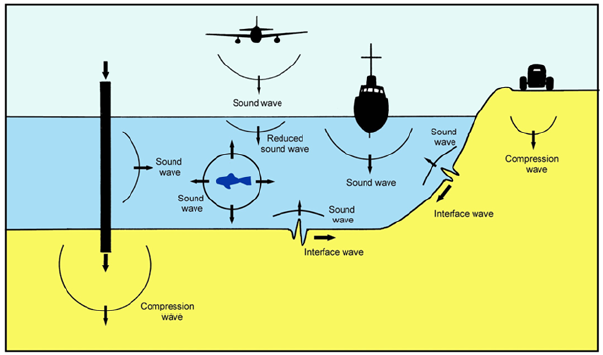
Sounds can come from boat engines and propellers, seismic air guns and trawls towed by vessels, pile driving construction work, and sometimes operational wind turbines), and vibration is also generated within the substrate. While most of the sounds arise from operations in the water, it is also apparent that vibration generated on land, for example by vehicle traffic and construction work, may also get into the water through the substrate.
Underwater sound is made up of two elements. Sound is generated by the movement or vibration of some immersed object and results from the inherent elasticity of the surrounding medium. There are waves of compression and rarefaction – termed the Sound Pressure. These are monitored by conventional aquatic hydrophones. However, in addition, as a result of motion of the sound source in the water, particles of the water are alternately forced together and then apart (Figure 2). This is termed the Particle Motion, which travels along the line of passage of the underwater sounds, and is a vector quantity. Particle motion levels are much higher in the near field, close to the source, especially at low frequencies. Fishes and invertebrates are moved back and forth by particle motion within the water, and are sensitive to it. It is possible for us to monitor the particle motion by detecting the particle displacement or its time derivatives, the particle velocity and particle acceleration, using a specialized hydrophone, and it is important to specify its direction. It is possible to monitor particle motion and its direction both in the water and on the substrate using accelerometers, orientated in 3 orthogonal directions, but often this is not done.
Figure 2: Particle Motion is Generated in Water.
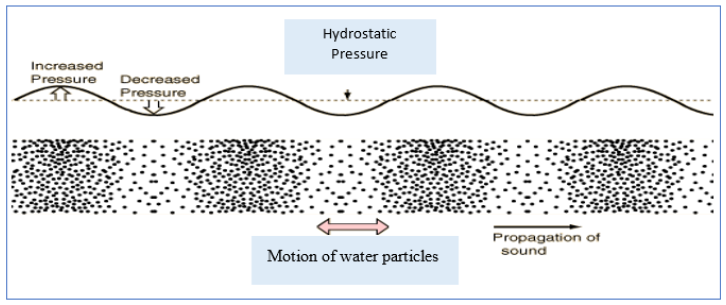
Sounds compress the water, and increase and decrease the hydrostatic pressure, and the Sound Pressure passes away from the source. There is back and forward motion of particles of the water, termed the Particle Motion, which also moves in a particular direction. Particle Motion levels are much higher in the Near Field, close to the source, especially at low frequencies.
Underwater sounds are generally monitored by measuring the sound pressure, which is what most hydrophones are sensitive to. The pressure acts in all directions (it is a scalar quantity). It is generally measured as levels of micro-Pascal (μPa). In a free or ideal sound field, especially in the open sea, the particle motion can be calculated from the measurement of the sound pressure, using wave equations; the plane wave equation or the spherical wave equation. In the far-field, distant from the source, the particle velocity is directly proportional to the sound pressure. Closer to the source the particle velocity is higher for a given sound pressure – the Near Field Effect. Sound is reflected and refracted at boundaries with different media: Close to the water surface, and in shallow water, the particle motion increases as a result of pressure release into the air. Under many aquatic circumstances it can be quite difficult to estimate the particle motion by measuring the sound pressure. The particle motion estimates are only possible under well-specified mid-water conditions, distant from reflecting boundaries. Such conditions do not prevail in small laboratory aquarium tanks, in very shallow water, or close to the sea surface or seabed.
Some aquatic animals are sensitive to the sound pressure but most fishes and invertebrates are sensitive to the particle motion, which enables them to determine the direction from which the sound is coming, and only a few fish species are sensitive to the sound pressure. Even those which can detect sound pressure may rely on detecting particle motion to determine the direction of a sound source through vector weighing.
Environmental Impact Assessments often emphasize that sounds, and especially low frequency sounds, do not travel well through shallow water. Although this is the case for sound pressure it may not be the case for particle motion. Particle motion levels in shallow water can be high, especially when sound is being transmitted through the seabed or the ground/water interface. Sound does propagate through the seabed, and the nature of marine substrate vibration has been described by Hawkins et al. [3]. Pile driving, seismic surveys and the operation of wind turbines generate substrate vibration – “ground roll”. The substrate vibration may travel great distances, generating particle motion and sound pressure in the water, especially at low frequencies. However, Environmental Impact Assessments often ignore the effects of particle motion, and the propagation of vibration through the substrate.
Human Sound Sources
Ships in the sea, lakes and rivers can be very noisy. The sounds generated by the vessels propagate along the surface, down into the water column, and can arrive close to the substrate. Variable sound levels and spectra are generated at different distances and depths. The sounds are generated by the ship engines, rotation of the propellers, and the creation of water flow and turbulence. In addition, many ships may also have other systems attached to them that can generate sound. For example, they include trawls that are towed across the seabed; sonar systems that are used to look at fishes and the seabed; and seismic air gun arrays towed by the ship that generate low frequency impulsive sounds that are used to detect oil and gas locations. The seismic air gun arrays not only generate sound in the water, they can also substrate vibration. They generate “ground roll”, a substrate vibration wave that occurs at the sea-floor (fluid/solid interface) and travels along the surface of the seabed. The wave is of maximum intensity at the interface and decreases exponentially away from the interface into both the water and the substrate solid medium. The ground roll wave travels slower than the speed of sound, but may travel considerable distances
The offshore oil and gas facilities may be noisy themselves as they operate, and also sounds and substrate vibration may be generated when the facilities are constructed by drilling, and other activities. Very loud sounds, and high levels of substrate vibration are generated by Pile Driving (Figure 3) – which is used for the installation of bridges, quays and offshore structures including oil and gas facilities and wind turbines. Some offshore installations can require extensive pile driving over several weeks.
Figure 3: Generation of sound and vibration by a Pile Driver.
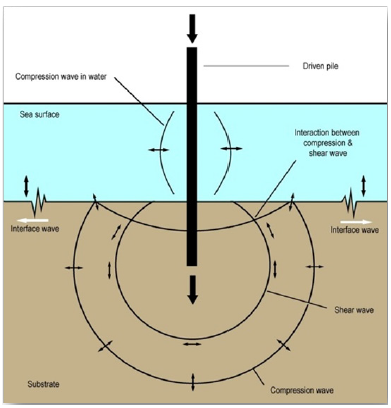
A strong and rigid pile is banged from above, resulting in sound propagation through the seabed as well as through the water. Pile driving is used for construction work close to the shore and also within the sea. Below-ground impact produces compression waves which propagate outwards. Shear waves and interface waves are also produced. Propagation velocities are highest for the compression waves, intermediate for shear waves, and lowest for interface waves. As the waves propagate away from the pile they begin to separate. In addition, they can decay at different rates but this decay is frequency dependent. Interface waves at the lower frequencies may dominate substrate transmission at long distances, showing the least attenuation
The actual operation of Wind Turbines and Oil and Gas Systems also generates sound and vibration. It has been confirmed that the wind turbines radiate sound mainly at a few dominating frequencies from 30Hz up to 800Hz [4]. At frequencies below 30Hz no contribution from the turbines can be detected due to the high background level from the waves and the low tower vibration level. Sounds are transmitted into the water via the vibration of the tower structure and vibration is also passed into the substrate. Wind farms are now being placed within the sea in many parts of the World. There is a real need to do some research on the possible adverse effects of wind farm construction and operation upon fishes and invertebrates. It is often suggested that the use of wind farms has enormous potential to deal with the current problems of climate change, by replacing more damaging energy sources. However, many marine fishes and invertebrates live within the parts of the sea, some near the seabed, where wind farms are likely to be built. In addition, migratory species like the salmon, sea trout and eels swim to and from rivers along the coast, and are likely to pass through mid-water areas occupied by offshore wind farms, some of which float at the surface. There is now a real need to obtain data on the impact of offshore wind farms upon fishes and invertebrates, as our current knowledge is rather poor. Electric cables are used to to convey the power generated by marine renewable energy installations to electrical sub-stations. The power cables are often installed across the sea, into coastal bays and even river mouths, and they connect the wind farm turbines to the mainland, and it is important to consider the potential effects of the Electrical and Magnetic Fields (EMFs) they generate upon marine species. A study at Heriot-Watt University in Edinburgh showed that lobster and crab eggs and larvae were deformed by the power cables. It is possible that the cables can result in animals being exposed to adverse effects in three ways. The electric field produced by the voltage applied to the cables can be damaging. The magnetic field produced by current flow on the cable can affect animals. And an indirect electrical field is induced by alternating magnetic fields from the cables or movement through a DC field of the earth or cables is also likely to be damaging [5]. It may be best to bury the power cables well under the seabed
The Importance of Sound to Aquatic Animals
Underwater sounds are very important to fishes and aquatic invertebrates. They especially use sounds to navigate through the water and to detect signals from natural environment sources, and from other animals. Some of the fishes are entirely pelagic, for example the herring (Clupeiformes), others are benthopelagic, for example the cod and haddock (Gadiformes), while a few species are entirely benthic, including the flatfishes (Pleuronectiformes), and many of the invertebrates. The vision ability of these animals in the water is generally poor and they use the “acoustic scene” to locate natural underwater features including preferred habitats, as well as their prey and predators, and they also use sound to set their orientation during migration. Sound travels further and faster in all directions through water than it does through the air and it allows aquatic animals to detect natural sources, and to communicate well with one another. Underwater sound is highly relevant to many aquatic animals. They listen to the “acoustic scene” and use this to orientate and navigate. Fishes mainly have ears that are sensitive to particle motion. There are two fish ears within the skull, each containing 3 otolith organs, the saccule, utricle and lagena (Figure 4), each of these organs containing a heavy mass (the otolith itself) and sensory hair cells that respond to the motion of the otolith. The fish itself, and the sensory tissues have approximately the same density as water and move back and forth in a sound field. However, the otolith is much denser and moves with a different amplitude and phase resulting in the hair cell bundles that are in contact with the otolith being subjected to a directional shearing force. However, some fishes have their gas-filled swim bladder close to the ear, where sound pressure causes volume oscillations which are transferred to the inner ear, often via a physical connection, e.g. through paired bladder extensions, additional air cavities or a series of bones. The compression of the swim bladder by sound pressure can therefore generate particle motion, especially at higher frequencies, stimulating the otolith organs and enabling such species to detect the sound pressure as well as the particle motion. Aquatic Invertebrates are also sensitive to particle motion. For example, the Lobster has hair fan organs that respond to particle motion, giving them low frequency audiograms. Of course, aquatic animals do not hear all frequencies within their functional hearing range. They are more sensitive to some frequencies than others. It is important to examine their audiograms.
Figure 4: The Otolith Organs of Fishes.
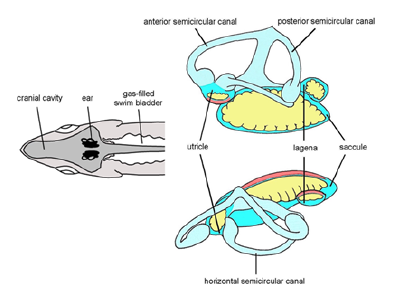
Each otolith (yellow) is a heavy calcareous lump, sitting on a membrane (pink) of sensory hair cells. The head of the fish is moved by the particle motion but the dense otoliths tend to move less, resulting in motion of the sensory hair cells. The hair cells in different parts of the air are orientated in different directions.
Many marine mammals, fishes and invertebrates make sounds themselves. Amongst the vocal fishes are some of the most abundant and important commercial fish species, including the cod & haddock (Gadidae). Many gadoid fishes make underwater sounds, and the sounds differ between species. Some produce knocking sounds, while others produce grunts. In all cases the sounds are pulsed, with each pulse generated by the contraction of a pair of Drumming Muscles attached to the gas-filled swim bladder (Figure 5). The muscles show very fast contraction.
Figure 5: Fish Sounds Are Produced by Muscles.
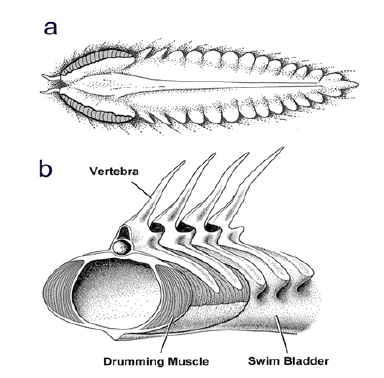
The muscles are often attached to the gas-filled swim bladder, as they are here in the Haddock. a is viewed from above, and b from the front, behind the head. The muscles are rather large and powerful, and the gas within the swim bladder is easily compressed.
The sounds produced by haddock, especially during courtship and mating, have been recorded and analyzed in the aquarium and in the sea [6,7]. The haddock produce sounds when they are feeding, mating, or fighting and they also make noises associated with swimming. They produce species-specific sounds, and even individual-specific sounds. Their sounds are often loud, and in areas where haddock are common their sounds may dominate the acoustic environment.
Fish sounds can vary in structure depending on the mechanism used to produce them, but they are generally composed of low frequencies, with most of their energy lying below 3kHz. So far, no high frequency sounds have been recorded from fish, although marine mammals can produce ultrasonic sounds. Many fishes, including the Atlantic cod and haddock make sounds during their spawning behavior. The male haddocks accumulate at particular spawning locations and use sounds to attract the females, and to advertise their presence at a particular location, that is especially useful for females that wish to engage in spawning with a male. The sounds are often varied during their spawning. For example, the male haddock makes sounds to attract females, and thousands of males gather together on the seabed making their sounds. The females are attracted and then select a particular male to spawn with, discriminating males with different characteristics through sound detection. The sounds of individual male haddock can readily be distinguished. The male haddock varies its sounds during the spawning behaviour, while the female remains silent then, but can make sounds normally. The different sounds produced by the male are shown in Figure 6.
Starting at the bottom the males make repeated knocks on the seabed. When the female arrives the male it selects leads the female up through the water and produces faster sounds, and it then mounts the female to spawn, producing sounds initially but then becoming silent when the female adds its eggs and the male its sperm into the water, to generate juveniles.
The differences between the sounds of different males on the seabed may enable females to select particular males. The sounds may also allow males to assess the strengths of other competing males. Each individual male may then join a female, and engage in spawning with it, making some specialized sounds at the start of the mating behavior. The male that is chosen then flaunts the female with a new sound, and then mounts the female to spawn but once it becomes attached to the female it stops making its sounds. The male and female embrace one another and release their eggs and sperm into the water to create juvenile haddock. However, human noise-making activities may affect spawning success by masking the haddock calls and driving haddock away from their spawning grounds.
Many other marine fishes also make sounds in the sea, including: cod, pollack, gurnards, bullheads, gobies, and blennies. However, there have been very few studies of sound producing fishes in the sea. lakes and rivers. Marine mammals, including whales and seals, that often prey upon fishes, also make sounds in the sea; and some invertebrates, including squid, lobsters, sea urchins, and some crabs, also make sounds. It is important for the management of fisheries for species like the haddock to determine where the stocks spawn. Listening with a hydrophone from a relatively quiet travelling boat is an effective non-invasive way of locating spawning fishes and mapping their spawning grounds [8].
The Hearing Abilities of Fishes & Invertebrates
Fishes and invertebrates can hear, and listening to natural sounds in their environment can be critical for their survival and reproduction. Hearing abilities are expressed in terms of hearing thresholds (the auditory thresholds). Conditioning experiments involve training the animals to respond every time a sound is presented. Once a response has been established the sound level can then be progressively lowered until the animal no longer responds, enabling the threshold to be determined. The threshold is the sound level at a particular frequency that is audible to an animal under quiet background conditions. Plotted as a function of frequency it provides the Audiogram. Electrophysiological methods register auditory evoked potentials (AEP) or auditory brainstem responses (ABR) by monitoring hair cell or brain responses. All the hearing thresholds are generally determined using pure tone sounds, at a number of frequencies. Only a small number of fishes and invertebrates have had their audiograms measured. Most of the audiograms are determined while measuring the sound pressure. However, it has been shown that the cod detects particle motion at frequencies below 100Hz, and only at higher frequencies detects the sound pressure [9].
Most hearing studies have been carried out in small aquariums in the laboratory, where the sound fields are highly complex as a result of the presence of pressure-release surfaces, and where it is almost impossible to set up and calibrate a reliable acoustic field with evident levels of particle motion. The particle motion components of the sound field are therefore, often completely ignored. Furthermore, background noise is often high over a wide range but especially at the lower frequencies and may mask the playback of sounds [10]. Any background noise that exists must be taken into account when determining auditory thresholds
thresholds and preparing an audiogram, but this has rarely been done. Some of the most interesting hearing experiments have been carried out in mid-water in the sea, where it is possible to estimate the particle motion levels from the sound pressure [11].
The Adverse Effects of Human-Made Sounds upon Aquatic Animals
The presence of adverse underwater sounds (often termed “noise”), and also substrate vibration, generated by human activities (anthropogenic sources) can be quite harmful to fishes and aquatic invertebrates, as the detection of sounds of interest to the animals can be adversely influenced by the presence of noises, whether the noises are natural sounds or sounds from human sources. The abilities of fishes and invertebrates to use sound to navigate, detect predators and prey, select habitat types, and communicate with one another, may be strongly affected by exposure to other sounds (noise). The noise may cause physical damage to the body tissues; damage to the auditory tissues, including the sensory hair cells; and changes to important behavior patterns, adversely affecting feeding migrations, and spawning. Masking of biologically important sounds, including those from the same species, may also be detrimental.
Many major developments are now taking place off our coasts, including: harbor re-developments; offshore oil and gas systems; offshore wind farms, fixed and floating tidal energy generators; wave energy generators. Noise levels in the sea, lakes and rivers have been changing dramatically as a result of human activities., and the noise that is being generated may have adverse effects upon aquatic animals. The sea, lakes and rivers are relatively dark, low-visibility environments, where it is difficult for animals to view things, and making and detecting sound is especially important.
The effects of sound on animals vary with distance from the source. However, modelling of particle motion levels at different distances from the source is rarely carried out in Impact Assessments. Models have recently been developed for dealing with ground roll generated by seismic surveys, but such models also need to be applied to pile driving and other sources of substrate vibration. Normally, assessments and modelling are only done in terms of sound pressure. Often: no mention is made of particle motion; no account is taken of substrate or interface waves; and sensitivity to Infrasound is ignored.
Great efforts are being directed at examining the effects of underwater noise upon marine mammals, but much less attention is being paid to effects upon fishes and invertebrates.
Marine mammals make up perhaps 100 species, but there are over 32,000 species of fishes and a great number of marine invertebrates. It is important to establish Sound Exposure Criteria for fishes & invertebrates. However, environmental impact assessments of offshore activities often involve dubious assumptions. Sound exposure criteria are often assumed rather than based on real data. The metrics employed are often inappropriate, especially for fish and invertebrates, which are primarily sensitive to particle motion, but the effects of the particle motion are often ignored. Sound propagation models have seldom been validated and they do not predict particle motion levels. They are especially poor for shallow water conditions or where sound travels through the substrate
Any interference with the acoustic scene can have a negative impact upon aquatic animals. It is important to examine the hearing abilities of aquatic animals. Much work has been done on the hearing of fishes, especially those living in the sea. There are substantial differences in hearing sensitivity and frequency range between different fish species. Most are sensitive to Particle Motion and only some are sensitive to Sound Pressure.
Dealing with the Effects of Noise
It is necessary to determine the levels of sound that may harm animals, in terms of particle Motion as well as Sound pressure, in order to develop criteria for the harm caused by sound exposure. Sound Exposure Criteria set limits to the received levels for particular sources, based on the levels above which damage or adverse effects may occur. The setting of such criteria was established initially for marine mammals [12]. However, very few criteria have been established for fishes and invertebrates. Environmental Impact Assessments often emphasize that sounds, and especially low frequency sounds, do not travel well through shallow water. Although this is the case for sound pressure it may not be the case for particle motion. Particle motion levels in shallow water can be quite high, especially when sound is being transmitted through the seabed or the ground/water interface. There have been few measurements of the particle motion levels generated by human aquatic activities. The transmission of particle motion through the substrate is hardly ever considered in assessing effects on animals.
In setting Sound Exposure Criteria, it is important to determine those sound pressure and particle motion levels that affect fishes and invertebrates adversely. Assessments of killing or injury, damage to the body tissues, including damage to the auditory system, or physiological damage, are generally done using sound pressure only, and there is a need for experiments where fish and invertebrates are shaken rather than squeezed. Behavioural responses must ideally be examined using free-living fish and invertebrates in the sea rather than in aquarium tanks.
References
- Popper AN, Hawkins AD, Fay RR, Mann DA, Bartol S, et al. (2014) Sound exposure guidelines for fishes and sea turtles. ASA press (Acoustical Society of America, Springer): S3/SC1.4 TR-2014
- Hawkins AD, Pembroke AE, Popper AN (2014a) Information gaps in understanding the effects of noise on fishes and invertebrates. Rev fish Biol Fisheries 25: 39-64.
- Hawkins AD, Hazelwood RA, Popper AN, Macey PC (2021) Substrate vibrations and their potential effects upon fishes and invertebrates. J Acoust Soc Am 149(4): 2782.
- Betke K, Manfred Schultz-von G, Rainer M (2004) Underwater noise emissions from offshore wind turbines. In Proc. CFA/DAGA.
- Normandeau, Tricas T, Gill A (2011) Effects of EMFs from Undersea Power Cables on Elasmobranchs and Other Marine Species. U.S. Dept. of the Interior, Bureau of Ocean Energy Management, Regulation, and Enforcement, Pacific OCS Region, Camarillo, CA. OCS Study BOEMRE 2011-09.
- Hawkins AD, Chapman CJ (1966) Underwater sounds of the haddock Melanogrammus aeglefinus (L.). Journal of the Marine Biological Association of the United Kingdom 46(2): 241–247.
- Hawkins AD, Amorim MCP (2000) Spawning sounds of the male haddock, Melanogrammus aeglefinus. Envir Biol Fishes 59: 29-41.
- Casaretto L, Picciulin M, Olsen K, Hawkins AD (2014) Locating spawning haddock (Melanogrammus aeglefinus) at sea by means of sound. Fish Res 154: 127–134.
- Chapman CJ, Hawkins AD (1973) A field study of hearing in the cod, Gadus morhua. J Comp Physiol 85: 147-167.
- Hawkins AD, Chapman CJ (1975) Masked auditory thresholds in the cod, Gadus morhua J Comp Physiol 103: 209-226.
- Hawkins AD Chapman CJ (2020) Studying the behavior of fishes in the sea at Loch Torridon, Scotland. ICES Journal of Marine Science 77(7-8): 2423-2431.
- Southall BL, Bowles AE, Ellison WT, Finneran JJ, Gentry RL, et al. (2007) Marine mammal noise exposure criteria: Initial scientific recommendations. Aquatic Mam 33(4): 411–521.
© 2022 Anthony Donald Hawkins. This is an open access article distributed under the terms of the Creative Commons Attribution License , which permits unrestricted use, distribution, and build upon your work non-commercially.
 a Creative Commons Attribution 4.0 International License. Based on a work at www.crimsonpublishers.com.
Best viewed in
a Creative Commons Attribution 4.0 International License. Based on a work at www.crimsonpublishers.com.
Best viewed in 







.jpg)






























 Editorial Board Registrations
Editorial Board Registrations Submit your Article
Submit your Article Refer a Friend
Refer a Friend Advertise With Us
Advertise With Us
.jpg)






.jpg)














.bmp)
.jpg)
.png)
.jpg)










.jpg)






.png)

.png)



.png)






